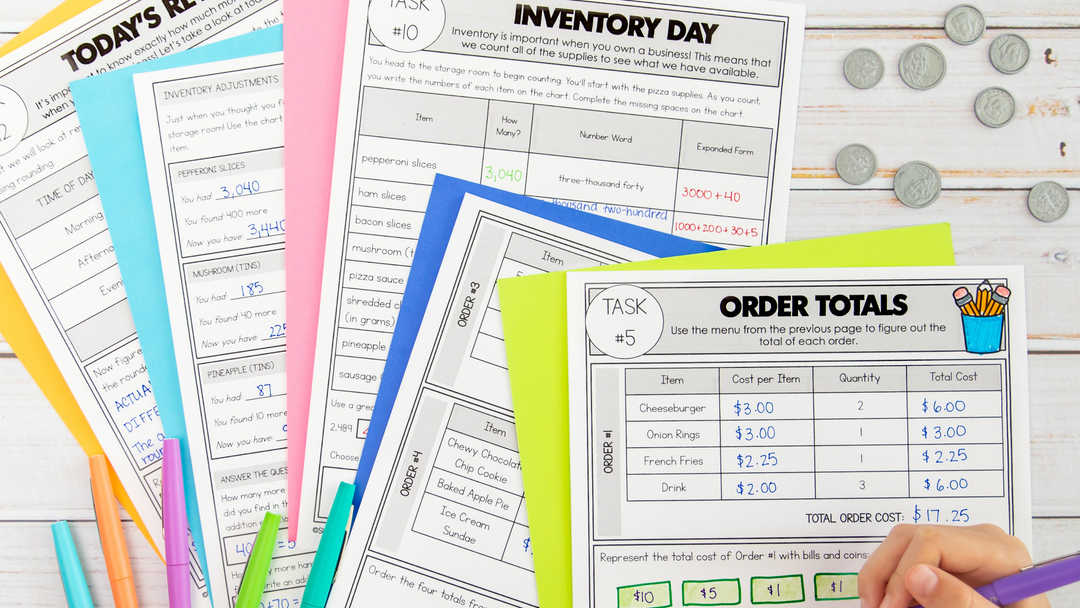About
Your students will practice place value skills while completing six different challenges (or obstacles) in order to make it home in this "Lost in the Desert" Escape Room-style activity. They'll crack codes and work together as a team, ultimately overcoming the obstacles and being rescued!
Are you ready for the challenge?
Ideas for Use
- Use the individual tasks as part of your math centers. Place one task at each center and have students rotate through them.
- Make a booklet for each student that includes all the tasks from this math project. Allow your students to choose the order that they complete the tasks, and use it as early finisher activities or morning work.
- Keep students engaged by allowing them to work through this package with a partner.
What's Included?
Your students will be completing six different challenges (or obstacles) in order to make it home.
Obstacle #1: Make it through the night.
The sun is already setting. You know that the best thing to do is to wait in your car for the night so that you don’t get even more lost. It gets cold in the desert when the sun goes down, so this could be a long night. You have something in the trunk of your car that will help.
YOUR TASK: Order the numbers from least to greatest. Then flip them over to reveal what was in the trunk of your car.
Obstacle #2: Read the mystery sign.
You made it through the night in the desert! But still no one has come along to rescue you. You are going to have to leave the car and walk for help. As you are walking, you see a sign that is almost covered by sand. You dig it up, but it’s written in some sort of code. You will have to figure out what it says!
YOUR TASK: Use the code sheet to decode the sign. Then complete the task on the number line.
Obstacle #3: Escape the scorpion.
Now that you know how far you need to go to get to the next road, you begin walking. After an hour you are tired and need a rest, so you sit down in the sand. Minutes later you feel something crawling on your hand. You look down. It’s a scorpion! You freeze in fear. You need to get it off!
YOUR TASK: Use the code sheet to figure out how you will get the scorpion off of your hand.
Obstacle #4: Get to the water.
You’re running low on water and you still have a long way to go to get to the road. But when you look ahead, you see a lake! You can’t believe it – this is your lucky day! You begin to run as fast as you can toward the lake. You can’t wait to jump in!
YOUR TASK: Get through the maze to get to the water.
Obstacle #5: Escape the rattlesnake.
As you got closer to the “water,” you realized it was just a mirage. There was no water there at all. Now you’ll have to get back to finding the road. You are tired, but you keep going. Suddenly you hear something. It’s rattling. You stop dead in your tracks. There is a rattlesnake RIGHT in front of you, and it’s getting closer. You want to run, but you know that the rattlesnake will feel threatened if you do. You need to move away slowly, but you are terrified. Then the rattlesnake does something.
YOUR TASK: Order the task cards from least to greatest. The letters will reveal what the rattlesnake does.
Obstacle #6: Get saved by the helicopter.
Thank goodness the rattlesnake turned away and left. You are so hot, so thirsty, and so tired. You need to find this road before you can’t walk any further. Suddenly you hear something. Is it a truck? An airplane? No – it’s a helicopter! A HELICOPTER!!!! You need to get its attention. You will quickly write a message in the sand and hope that the pilot sees it!
YOUR TASK: Shade the squares on the hundred chart to reveal the message.
What Teachers Are Saying
⭐️⭐️⭐️⭐️⭐️ "My summer camp students LOVED this resource. I can't wait to use it again later in the school year. It was engaging and encouraged team work." Mary N.
⭐️⭐️⭐️⭐️⭐️ "My class loved this activity! It was a great activity for those who finished their work quickly. I love activities that work on math skills while being super engaging and this definitely fit the bill! Thanks!" Chelsea L.
⭐️⭐️⭐️⭐️⭐️ "My students loved this activity. We used it to practice cooperation and working towards a common goal in small groups." Stephanie S.












